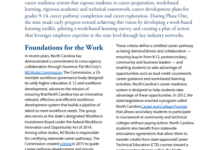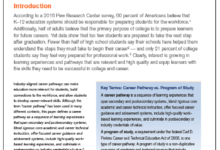This brief from Jobs for the Future has three goals:
•To begin an assessment of policy elements and strategies that are required for putting grades 9-14 pathways systems in place;
•To highlight a selection of state efforts that can serve as models to support elements of 9-14 pathways design and rollout; and,
•To describe policies that are not currently in place but would be desirable to facilitate the involvement of intermediaries, employers, and industry groups.
This paper begins with a discussion of the composition of state leadership teams and organizing structures for supporting 9-14 pathways and describes effective strategies drawn from over a dozen states within the Pathways to Prosperity Network and beyond. The paper also includes a review of state policies that support 9-14 collaborations, including dual enrollment, CTE policy and funding. The paper identifies career counseling, work-based learning and employer engagement as elements of a career pathways system that are less developed across the country.







